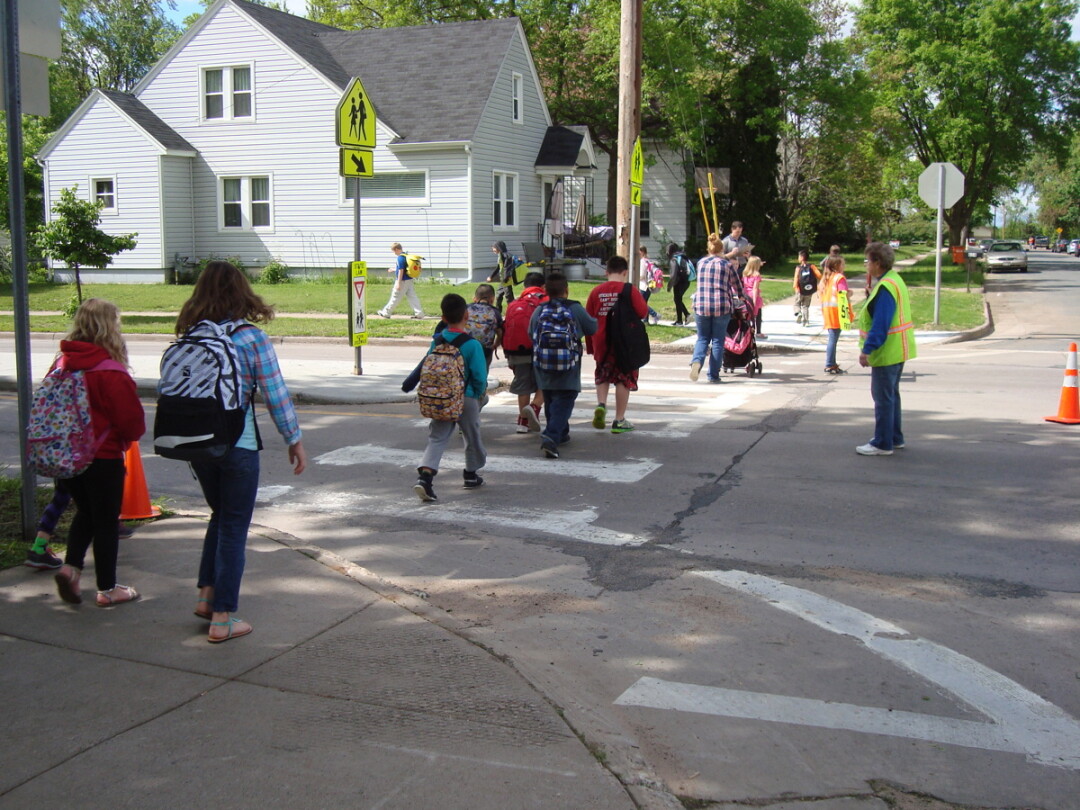Taking Steps Toward Safety
community effort identifies safe ways for kids to walk to school

Like they have for generations, children are returning to school in the Chippewa Valley this fall with new sneakers, smiling faces, and backpacks stuffed with spiral notebooks, No. 2 pencils, and tissue boxes.
Unlike previous generations, however, today’s kids are far more likely to arrive at school via bus, car, or minivan than on foot.
Fifty years ago, according to the Pedestrian and Bicycle Information Center, about 48% of American kids aged 5-14 nationwide walked or biked to school. Among those who lived within a mile of their schools, 89% walked or biked.
Today’s statistics, at least in the Chippewa Valley, are low by comparison: Surveys from the Altoona, Chippewa Falls, and Eau Claire school districts have found that just 16% of students walk or bike to school. (The figure excludes students attending Chippewa Valley Montessori Charter School, Jim Falls, Stillson, and Altoona elementary schools, most of whom live farther than one mile from school.)
Fifty years ago, about 48% of American kids aged 5-14 nationwide walked or biked to school. Today, only 16% of kids in the Chippewa Valley do the same.
To combat this trend, communities around the nation – and world – have become part of the Safe Routes to School movement. Last year, the West Central Wisconsin Regional Planning Commission helped the the Eau Claire school district create a Safe Routes to School Plan, a process the agency had also gone through with the Chippewa Falls and Altoona school districts. The ultimate goal of the detailed planning document – which includes maps, survey data, and issues relating to each school – is to encourage more children to walk and bike to class, said Lindsay Olson, an associate planner with the regional planning commission.
“Overall, our primary goals in communicating the Chippewa Valley Safe Routes to Schools Partnership initiative to the public is to generate awareness of the plans and routes, help drivers to be more aware of school zones and pedestrian students, and motivate more students (and parent support) to safely walk and bike to school,” she said.
As part of the process, planners worked with school officials, city engineers, and health department representatives to create a more walkable environment. Surveys of parents helped identify why so few students were walking to school: Safety of intersections was cited by 47% of parents, while many also noted the distance from home to school, Wisconsin’s extreme weather, as well as the convenience of driving.
Walk and bike audits were conducted at Eau Claire schools, and they “found that excessive traffic speed and inattentive drivers were a district-wide issue and a major concern.” As one adult crossing guard at Robbins School said, “Drivers act like these red signs are just suggestions.” Input from parents and schools also helped pinpoint specific solutions – such as adding a sign here or painting a crosswalk there – that would improve safety and walkability.
There are plenty of benefits to encourage kids to go to school under their own power. For one, walking is good exercise and helps kids achieve the often-state goal of 60 minutes of exercise a day, the Safe Routes to School Plan notes. In addition, fewer cars means cleaner air and less wear and tear on streets. And encouraging the improvement of sidewalks, crosswalks, trails, and other kinds of pedestrian infrastructure helps walkers of all ages, not just schoolkids.
Now that the school year is starting, students in the Chippewa Falls and Altoona districts should receive brochures identifying safe routes to and from neighborhood schools as well as the location of crossing guards. (Similar information for Altoona schools is available on the district’s website.)
In addition to encouraging kids to walk and bike, Olson also hopes public attention to the Safe Routes to Schools program helps remind drivers to take extra care when they see kids.
“We’ve been trying to do more on the education side to educate the public that school zones are not an option,” Olson said. “It’s state law. Drivers also have to obey the signs of adult crossing guards. we’re trying to get the word out more about respecting school crossing guards and safety for the students.”
To view the Safe Routes to School Plan for the Eau Claire school district, visit tinyurl.com/ECASDsaferoutes




















